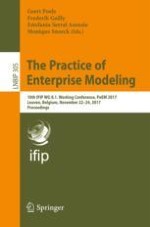
2017 | OriginalPaper | Chapter
Domain Modelling in Bloom: Deciphering How We Teach It
Authors : Daria Bogdanova, Monique Snoeck
Published in: The Practice of Enterprise Modeling
Publisher: Springer International Publishing
Activate our intelligent search to find suitable subject content or patents.
Select sections of text to find matching patents with Artificial Intelligence. powered by
Select sections of text to find additional relevant content using AI-assisted search. powered by